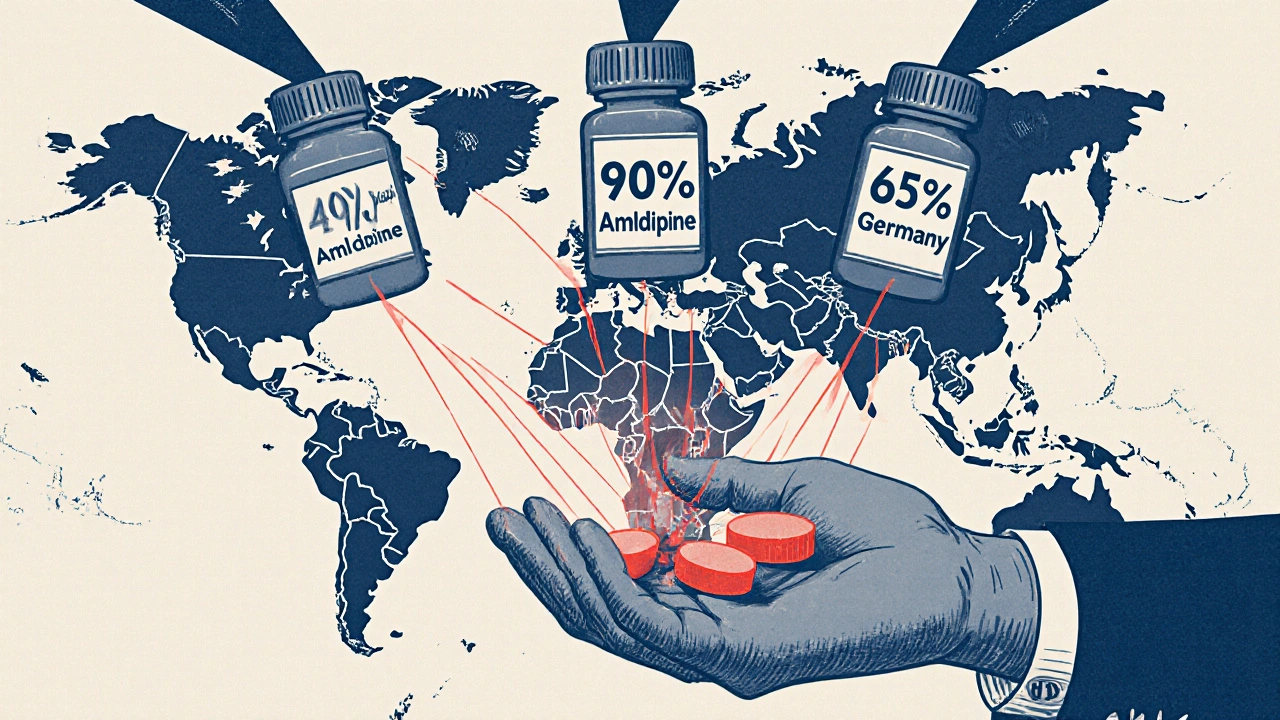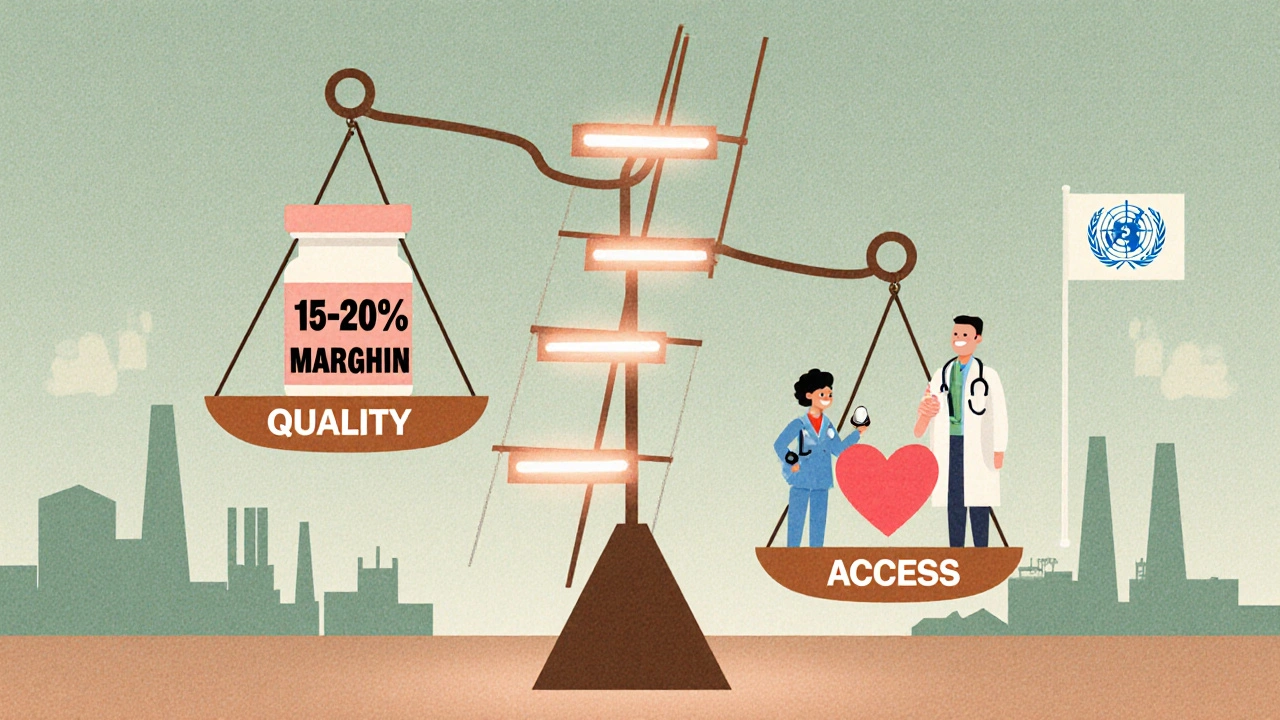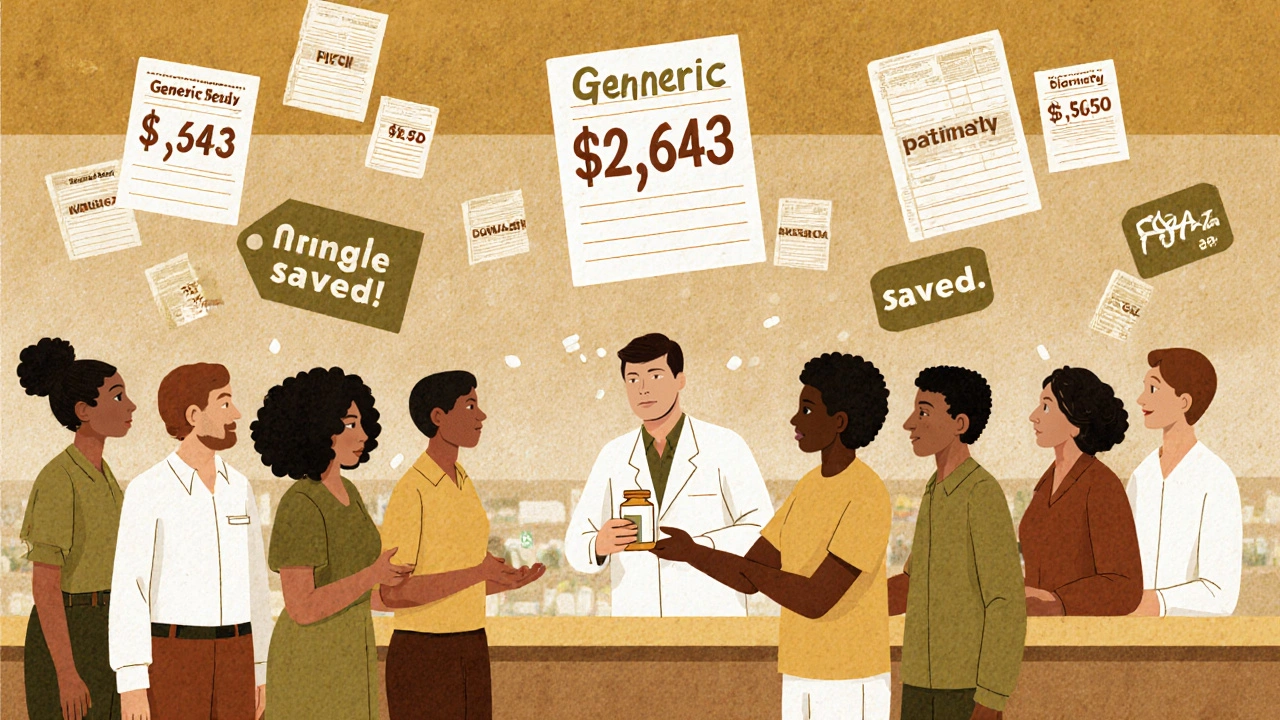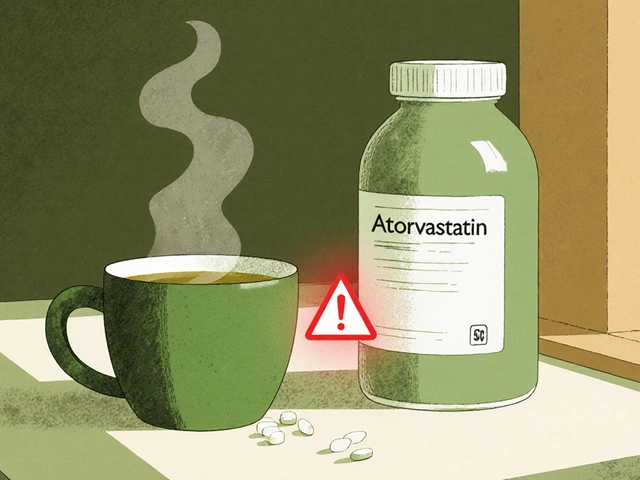When you pick up a prescription at the pharmacy, chances are you’re getting a generic drug. In the U.S., generic drugs make up 90.1% of all prescriptions filled. But what you might not realize is that how these drugs are approved, priced, and distributed varies wildly from country to country. Some nations slash prices to the bone. Others protect manufacturers. Some force pharmacists to substitute. Others leave it up to doctors. The global system for generic medicines isn’t just about science-it’s about politics, economics, and survival.
Why Generics Matter More Than Ever
By 2025, the global market for generic drugs hit $468 billion. That number is expected to climb to over $728 billion by 2034. Why? Because chronic diseases like diabetes, heart disease, and high blood pressure are rising fast, especially in aging populations. And healthcare budgets are stretched thin. Governments need affordable options. Generics deliver the same active ingredients as brand-name drugs, often at 80-90% lower prices. In the U.S., Medicare saved $142 billion in 2024 just from using generics-$2,643 per beneficiary. In the European Union, generics account for 65% of prescriptions but only 22% of total drug spending. That’s the power of generics: they don’t just cut costs-they free up money for other care. But here’s the catch: getting to that savings isn’t automatic. It depends entirely on how a country designs its policies. And those designs are anything but uniform.The U.S. Model: High Volume, Low Prices, Big Savings
The U.S. leads the world in generic use. Nearly all prescriptions are filled with generics. But that doesn’t mean U.S. drug prices are low overall. Brand-name drugs still cost more here than anywhere else. The trick? Generics are dirt cheap. The FDA’s Orange Book lists over 11,300 approved generic products. Many are produced by just a few manufacturers, which drives competition. The system works because of the Hatch-Waxman Act of 1984, which created a fast-track approval process called the Abbreviated New Drug Application (ANDA). Generic makers don’t need to repeat expensive clinical trials-they just prove their version works the same as the brand. There’s a twist: the FDA gives 180 days of exclusive rights to the first company to challenge a brand-name patent. That’s called a Competitive Generic Therapy (CGT) designation. In August 2025, Zenara Pharma got CGT approval for its version of sertraline, a common antidepressant. That meant they had a head start on competitors-and could recoup their $5.9 million development cost before others jumped in. But it’s not all smooth sailing. Pharmacy Benefit Managers (PBMs), the middlemen who negotiate drug prices for insurers, sometimes set higher copays for generics than for brand-name drugs. Patients on Reddit’s r/AskDocs reported 63% frustration with this. Why pay more for a cheaper drug? It’s a system glitch.Europe: Harmonized Rules, Fragmented Prices
The European Union has one of the most complex systems. The European Medicines Agency (EMA) approves generics for the entire bloc. But then? Each country sets its own price. That means two identical pills, made in the same factory, can cost three times more in one country than another. In Germany, 88.3% of prescriptions are generics. In Italy, it’s only 67.4%. Why? Because Italy doesn’t push substitution as hard. Germany does. Countries like the Netherlands use external reference pricing. They look at what France, Belgium, the UK, and Norway charge-and then set their own price even lower. It’s a clever workaround. But it creates instability. Manufacturers can’t plan. Pharmacies get confused. And patients sometimes get different versions of the same drug when they travel. The EU is trying to fix this. A new Pharmaceutical Package, expected in late 2025, will try to harmonize pricing rules and speed up generic entry. The goal? Reduce delays by 12-15%. But with 27 different governments involved, change moves slowly.China: The Bulk-Buying Giant
China’s approach is brutal-and effective. Since 2018, it’s used Volume-Based Procurement (VBP). The government doesn’t negotiate with one pharmacy or hospital. It negotiates with the entire country. It says: “We’ll buy 80% of your hospital’s demand for this drug. You bid lowest price. Winner gets the contract.” The results? Average price drops of 54.7%. In some cases, like certain blood pressure meds, prices fell by 93%. By 2025, over 1,000 drugs were included in VBP. But there’s a dark side. Manufacturers are losing money. A 2025 survey found 23% of generic makers in China are selling at a loss just to win VBP contracts. And when you’re operating at razor-thin margins, quality suffers. Some hospitals reported shortages of amlodipine, a common heart medication, for weeks in 2024. Patients didn’t get their pills. Why? Because no one wanted to make it at the price the government set. China’s National Medical Products Administration (NMPA) now approves generics in 10-12 months. But if you can’t make a profit, why bother?
India: The World’s Pharmacy
India produces 20% of the world’s generic medicines by volume. It’s the go-to source for low-cost drugs for Africa, Latin America, and even parts of Europe and the U.S. How? Because India’s patent laws let generic companies make versions of branded drugs before patents expire-under what’s called compulsory licensing. Section 84 of India’s Patents Act allows this if a drug is too expensive or not available in sufficient quantity. That’s why so many HIV and hepatitis C drugs from India are sold globally at a fraction of the U.S. price. But there’s a trade-off. The FDA issued 17% more warning letters to Indian generic manufacturers between 2022 and 2024. Many cited data integrity issues-fake test results, missing records, sloppy labs. The Access to Medicine Foundation warns that chasing low prices can erode quality. And when quality drops, patients pay with their health.South Korea: The Precision System
South Korea didn’t just lower prices. It redesigned the entire system. In 2020, it introduced the “1+3 Bioequivalence Policy.” Only three generic versions of a drug can be approved using the same bioequivalence data. That cuts down on redundant, low-quality copies flooding the market. Then, in 2021, it added a pricing ladder:- Generics meeting both quality and price standards: 53.55% of brand price
- Those meeting only one: 45.52%
- Those meeting neither: 38.69%
The Hidden Risk: Quality Under Pressure
Across all these systems, one danger keeps appearing: when prices are crushed, quality suffers. The FDA’s import alerts for substandard generic drugs jumped from 1,247 in 2020 to 2,183 in 2024. Most came from India and China. These aren’t just paperwork problems. They’re about whether a drug dissolves properly in your body. For drugs like warfarin or epilepsy meds, even a small difference can be deadly. The WHO warns that aggressive price controls threaten manufacturing resilience. If a company can’t make a profit, it won’t invest in better equipment, training, or quality control. And when a shortage hits-like the 2024 amlodipine gap in China-patients go without.
What Works? What Doesn’t?
There’s no perfect model. But some patterns emerge:- High generic use (like the U.S. and Germany) = big savings
- Transparent pricing (like South Korea’s ladder) = better quality control
- Centralized bulk buying (like China) = fastest price drops, but risky for supply
- Fragmented pricing (like the EU) = confusion, inefficiency, wasted money
- Weak oversight (in some emerging markets) = dangerous quality gaps
The Future: Patent Expirations and New Rules
Between 2025 and 2030, $217-$236 billion in brand-name drug sales will lose patent protection. That’s a flood of new generic opportunities. But only if policies allow it. In the U.S., the Inflation Reduction Act lets Medicare negotiate prices for 10-20 high-cost drugs each year starting in 2026. That could push more patients toward generics. In the EU, the new Pharmaceutical Package may cut approval times. In China, VBP will expand to 150 more drugs in January 2026-with prices averaging 65% below current levels. But the biggest threat isn’t policy. It’s consolidation. Right now, there are about 3,500 generic manufacturers worldwide. By 2030, McKinsey predicts only 2,200 will survive. The rest will be squeezed out by low margins. The winners? Companies that control everything-from R&D to manufacturing to distribution. The losers? Patients who rely on affordable, reliable drugs.Final Thought: Affordability Without Sacrifice
Generics are one of the most powerful tools in modern medicine. They make life-saving drugs accessible to millions. But they’re not magic. They need smart policy. They need oversight. They need manufacturers who can stay in business without cutting corners. The goal isn’t to make drugs as cheap as possible. It’s to make them affordable-without breaking the system that makes them.Are generic drugs really as effective as brand-name drugs?
Yes, when approved by regulators like the FDA or EMA, generic drugs must contain the same active ingredient, dosage, and strength as the brand-name version. They must also be bioequivalent-meaning they’re absorbed into the body at the same rate and extent. Studies show they work just as well for most conditions. The main differences are in inactive ingredients (like fillers) and packaging, which don’t affect how the drug works.
Why do some people say generic drugs don’t work as well?
Some patients notice differences in size, color, or how the pill feels. For drugs with a narrow therapeutic index-like warfarin, thyroid meds, or seizure drugs-even small variations in absorption can matter. In rare cases, poorly made generics (especially from unregulated manufacturers) may not dissolve properly. But these are exceptions. Most generics are safe and effective. If you feel a difference, talk to your pharmacist or doctor-they can help you switch back or find a better brand.
Why are generic drugs cheaper if they’re the same?
Brand-name companies spend billions on research, clinical trials, and marketing to get their drug approved. Generic makers don’t. They only need to prove their version works the same. That cuts development costs from $1 billion+ to around $5 million. Plus, once multiple companies make the same drug, competition drives prices down. It’s not magic-it’s basic economics.
Can I trust generics made in India or China?
Many generics from India and China meet international standards and are used safely worldwide. But not all do. The FDA has increased inspections and import alerts because of quality issues in some facilities. Look for generics approved by your country’s health authority (like the FDA, EMA, or Health Canada). Avoid buying unregulated generics online. If your pharmacy sources from a reputable distributor, the risk is low.
Why do some countries have more generic options than others?
It depends on patent laws, pricing rules, and how fast regulators approve new generics. Countries like India and the U.S. have strong incentives for generic makers to enter the market quickly. Others, like Japan or South Korea, limit the number of generics allowed to protect quality or control prices. It’s not about capability-it’s about policy choices.
Will generic drug prices keep falling?
In markets with strong competition and bulk buying (like the U.S. and China), prices will likely keep dropping. But there’s a limit. If prices fall below manufacturing cost, companies stop making the drug. That leads to shortages. The trend now is shifting from “lowest price possible” to “sustainable price”-enough to cover costs and quality control. That’s better for patients in the long run.







9 comments
mike tallent
Generics are literally lifesavers for people on fixed incomes 🙌 I know a guy with diabetes who pays $4 for his metformin instead of $400 for the brand. That’s not a luxury-that’s survival. The system ain’t perfect, but without generics, millions would just skip doses or go without. Let’s not break what’s working.
Joyce Genon
Okay but let’s be real-this whole ‘generics are just as good’ narrative is corporate propaganda. I’ve had generics that made me dizzy, nauseous, and totally out of it. The FDA’s bioequivalence range is 80-125%-that’s a 45% swing in absorption. That’s not ‘the same,’ that’s a crapshoot. And don’t even get me started on the Chinese labs with no running water and lab coats made of trash bags. This isn’t healthcare-it’s a global lottery.
John Wayne
It’s amusing how Americans treat generics like a moral victory while ignoring the fact that the entire system is a product of regulatory capture. Hatch-Waxman was never about patient access-it was a deal between Big Pharma and Big Generic to avoid competition while maintaining pricing control. The 180-day exclusivity window? That’s not innovation-it’s collusion dressed up as policy.
Julie Roe
Look, I get why people are nervous about generics-especially if you’ve had a bad experience. But the truth is, most of the time, it’s not the drug-it’s the placebo effect or the change in pill shape. I used to have a patient who swore her generic blood pressure med didn’t work because it was blue instead of green. We switched her back to brand and she felt better… until we told her it was the same generic again. She didn’t know the difference. Education matters more than we think. And yeah, quality control is a real issue in some countries, but the FDA’s import alerts are getting better. We just need more funding, not more fear.
jalyssa chea
i think the real problem is that the government lets big pharma write the rules and then acts shocked when people get sick from bad generics like why arent they testing more like come on its not that hard to check if the pill dissolves in water and also why do we even let companies from india make our meds they cant even keep their own streets clean
Gary Lam
So China cuts drug prices by 93%… and then people can’t get their meds because no one wants to make them at a loss? Sounds like a socialist dream turned into a capitalist nightmare. Meanwhile, in the U.S., we pay $100 for a pill that costs $0.10 to make, and everyone’s like ‘free market!’ 🤡 Meanwhile, India’s churning out $0.50 HIV meds for Africa while the FDA sends them warning letters. The world is a circus, and we’re all clowns with prescriptions.
Peter Stephen .O
Generics are the unsung heroes of modern medicine-like the quiet kid in class who aced the test without bragging. They don’t need flashy ads or fancy packaging. Just clean labs, solid science, and a little competition. And yeah, some countries go too far-crushing margins until factories shut down. But the fix isn’t to abandon generics-it’s to build smarter systems. South Korea’s pricing ladder? Genius. China’s bulk buying? Bold. The U.S.? We’re stuck in the middle-using generics like a utility but letting PBMs screw the patient. We need policy that rewards quality, not just the lowest bid. Because when a pill doesn’t dissolve? It’s not a glitch-it’s a tragedy.
Andrew Cairney
EVERYTHING ABOUT GENERICS IS A LIE. The FDA? Controlled by Big Pharma. The ANDA process? A backdoor for counterfeiters. The WHO? In bed with the WHO? No wait-the WHO is part of the globalist agenda to depopulate us through substandard meds. Did you know the same labs that make your generic metformin also make drone parts for the UN? That’s why your blood sugar spikes-because the pills are coded to destabilize your endocrine system. And don’t even get me started on the 5G chips embedded in the fillers. You think that’s a coincidence? Wake up.
Rob Goldstein
Let’s not lose sight of the clinical reality: generics are bioequivalent in >95% of cases, and the vast majority of adverse events attributed to them are psychosomatic or due to non-adherence. The real issue is systemic-fragmented supply chains, lack of pharmacovigilance in low-resource settings, and the erosion of manufacturing capacity due to unsustainable pricing. We need a tiered approval model-where generics are categorized by risk profile, not just price. High-risk drugs (anticoagulants, antiepileptics) need stricter bioequivalence thresholds and real-time batch tracking. Low-risk ones? Let the market compete. And we need to incentivize domestic production-not just for cost, but for resilience. This isn’t about ideology. It’s about pharmacokinetics and public health infrastructure.